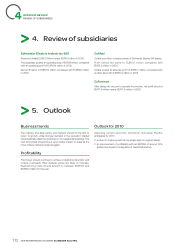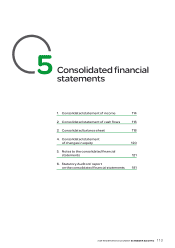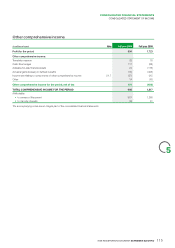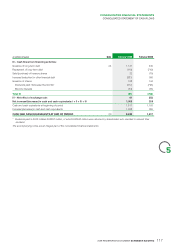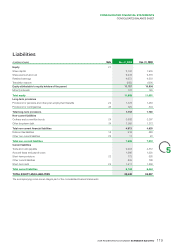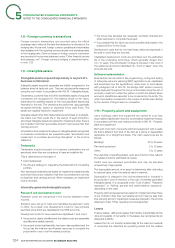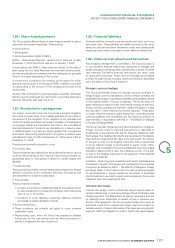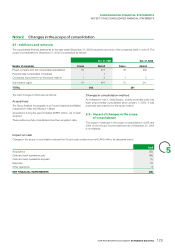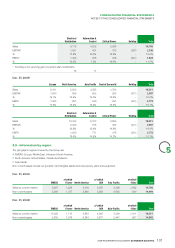APC 2009 Annual Report Download - page 124
Download and view the complete annual report
Please find page 124 of the 2009 APC annual report below. You can navigate through the pages in the report by either clicking on the pages listed below, or by using the keyword search tool below to find specific information within the annual report.
2009 REGISTRATION DOCUMENT SCHNEIDER ELECTRIC122
CONSOLIDATED FINANCIAL STATEMENTS
5NOTES TO THE CONSOLIDATED FINANCIAL STATEMENTS
Note1
Summary of significant accounting policies
1.1 - Accounting standards
Schneider Electric’s consolidated fi nancial statements have been
prepared in compliance with the international accounting standards
adopted by the European Union as of December 31, 2009. The
same accounting methods were used as for the consolidated
fi nancial statements for the year ended December 31, 2008, with
the exception of the changes in method described in paragraph1.2
and the adoption of the revised version of IAS1 - Presentation of
Financial Statements. The main differences with the previous version
of IAS1 are as follows:
(i) all changes in equity arising from transactions with owners of
the parent are segregated from those arising from transactions
with minority owners of subsidiaries;
(ii) income and expenses are presented in two statements (a
separate income statement and a statement of comprehensive
income);
(iii) comprehensive income is disclosed in the fi nancial statements.
As concerns segment information, Schneider Electric has been
gradually deploying a new organisation by business that became
fully operational as of January 1, 2010. As a result, segment
information for 2009 refl ects this new organisation , in accordance
with the requirements of IFRS8 – Operating Segments, which is
being applied for the fi rst time. However, because information on
the new basis of segmentation is not available for the year ended
December 31, 2008, segment information is provided on the old
basis for 2009 and 2008 for purposes of comparison, in accordance
with paragraph30 of IFRS8.
The following standards and interpretations that were applicable
during the period did not have a material impact on the consolidated
fi nancial statements for the year ended December 31, 2009:
•IAS23 R - Borrowing Costs (requires capitalisation of borrowing
costs);
•amendment to IFRS 2 – Share-based Payment (vesting
conditions and cancellations);
•IAS 32 R - Financial Instruments: Presentation and IAS1 R -
Presentation of Financial Statements (puttable instruments and
obligations arising on liquidation);
•IFRS1 R - First-time Adoption of International Financial Reporting
Standards and IAS 27 - Consolidated and Separate Financial
Statements (cost of a subsidiary, jointly controlled entity or
associate);
•IFRS improvements (May2008);
•IFRS 7 A - Financial Instruments: Disclosures (enhancing
disclosures about fi nancial instruments);
•IFRIC9 and IAS39 A - Embedded Derivatives;
•IFRIC13 – Customer Loyalty programmes .
There are no differences in practice between the standards applied
by the Group as of December 31, 2009 and the IFRSs issued by the
International Accounting Standards Board (IASB), as the application
from January 1, 2009 of the standards and interpretations not yet
adopted by the European Union would not have a material impact
on the Group’s accounts.
Lastly, the Group did not apply the following standards and
interpretations that have not yet been adopted by the European
Union or that are applicable after December 31, 2009:
•IFRS3 R - Business Combinations;
•IAS27 R - Consolidated and Separate Financial Statements;
•IFRIC14 R - Prepayments of a Minimum Funding Requirement;
•IFRIC12 - Service Concession Arrangements;
•IFRIC15 - Agreements for the Construction of Real Estate;
•IFRIC16 - Hedges of a Net Investment in a Foreign Operation;
•IFRIC17 - Distributions of Non-cash Assets to Owners;
•IFRIC18 - Transfers of Assets from Customers;
•IFRIC 19 - Extinguishing Financial Liabilities with Equity
Instruments;
•IAS39 A - Financial Instruments: Recognition and Measurement
– Exposures Qualifying for Hedge Accounting;
•IFRS1 R - First-time Adoption of International Financial Reporting
Standards;
•IFRS1 A - First-time Adoption of International Financial Reporting
Standards (additional exemptions for fi rst-time adopters);
•IFRS 2 A - Share-based Payment (Group cash-settled share-
based payment transactions);
•IFRS improvements (April2009);
•IAS32 A - Financial Instruments: Presentation (classifi cation of
rights issues);
•IAS24 R - Related Party Disclosures;
•IFRS9 - Financial Instruments.
The potential impact of these standards and interpretations on the
consolidated fi nancial statements is currently being assessed. At
this stage of analysis, the Group does not expect their impact to be
material, except for IFRS3 (revised), which will modify prospectively
the accounting treatment of business combinations and IFRS9, for
which an impact analysis has not yet begun due to the standard’s
date of publication and incomplete nature.
The financial statements provide data prepared in accordance
with IFRS for the years ended December 31, 2009 and December
31, 2008. The fi nancial statements for the year ended December
31, 2007, presented in the Registration Document registered with
Autorité des Marchés Financiers (AMF) under number 08-0112 on
March 17, 2008, are incorporated by reference.
1.2 - Changes in accounting method
Consolidation of jointly controlled entities
As from January 1, 2009, investments in operating entities controlled
jointly with a limited number of partners, such as joint ventures and
alliances, are proportionally consolidated in accordance with the
recommended treatment under IAS31 - Interests in Joint Ventures.
Before January 1, 2009, the Group accounted for jointly controlled
entities by the equity method in accordance with the alternative
treatment allowed under IAS31. This change is designed to
provide more meaningful information on the strategic nature of
jointly controlled entities and the way in which their operations are
tracked by Schneider Electric management. The impact on the 2008
comparative statements is not material.
Presentation of the interest component of defined
benefit pension plan costs
Until now, all costs related to defined benefit pension plans,
termination benefi ts and other post-retirement benefi t obligations
were recognised in operating profi t. To provide a more meaningful
picture of operating profi t by excluding all fi nancial income and


